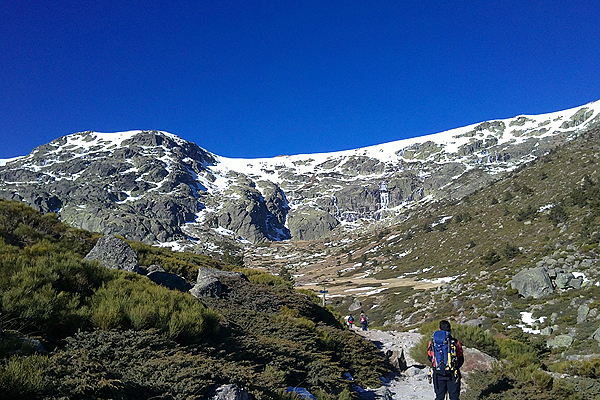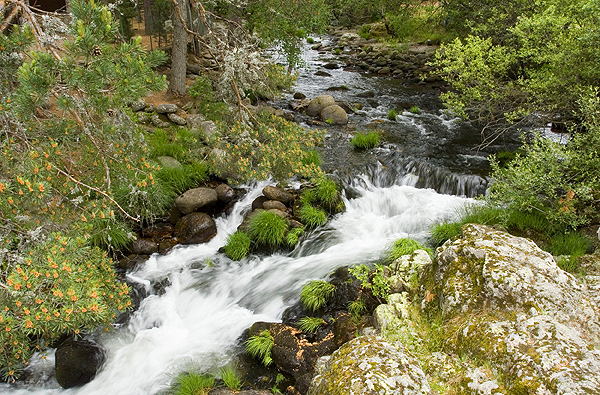Holidays in Rural Madrid
Everything you need to plan the perfect holiday in Madrid: how to get there, the best places to stay, the best times of year to go, and an unbeatable selection of hand-picked holiday villas and cottages.
Find your Holiday home in Madrid
Summary
“From Madrid to heaven” goes the local saying.
Situated at the very heart of Spain at 650 metres, Madrid is Europe’s highest capital, which may go some way towards explaining the extraordinary quality of its light.
It also gives a head start to reaching its nearby mountains, where healthy high-altitude treks go perfectly with the buzz of the city.
World-class museums, sporting events, specialist shops and flea markets, countless cake and pastry shops, bars, cafés and restaurants with professional waiters serving the terraces, all share a modern but unpretentious style in a city where sunlight illuminates beautiful architecture with an uncanny clarity.
The gentle mountains of the Sierra de Guadarrama are close by and their good road and rail links now make rural tourism a thrilling option for those who want to see the city but stay in tranquil villages, where the air is scented with sweet pine and paths invite young and old alike to discover lagoons, forest, waterfalls and heavenly views.
Overview
THE CAPITAL
It’s easy to feel at home in Madrid, where the major attractions are all within walking distance. If rival Barcelona is more cosmopolitan and European, the capital remains thoroughly Spanish in a way that takes the edge off the busy pace of the capital.
Madrid is friendly with a vibrant feel that puts a spring into the visitor’s step while putting them at their ease. The madrileños are typically social people who love to get together and chat, which means cafés and bars are not only everywhere, they are often full.
The city, considerably smaller than other European capitals, is easy to get around either on foot or on the excellent Metro or bus system. Taxis are also relatively inexpensive.
You can walk from the Puerta del Sol square–from where all distances are measured in Spain–to the old Plaza Mayor, the renovated opera house or the fountain of Cibeles, the city’s patron goddess. From here the fabulous old post office building heads a tree-lined avenue that leads past the Prado, Thyssen and Reina Sofia museums to the huge, central Retiro Park and its leafy walkways, lawns, lakes and exhibitions at the Glass Palace.
Madrid leads a doubly busy life. Once work is over and night falls, the populace makes for the countless bars and terraces, often until the early hours of the morning. Some of these are delightful old taverns where sherries are served from oak barrels and the cañas (small glasses of beer) are always light and refreshing.
The madrileño may start the evening with tapas and aperitifs, always in company, and then move on to a dinner finished off with generous measures of spirits. The people are approachable and attractive and yet statistics suggest that they are the population in Spain that has the least sex and spends the least time in bed. They must simply be too busy socializing with friends.
Immigration has always played a significant role in Madrid’s history, and the city’s varied gastronomy is thanks to the different dishes adopted from northern Galicia, the Basque country and southern Andalusia.
More recent arrivals from the eastern Mediterranean, South America and Bangladesh have added shawarmas, ceviche and curries to an extraordinary mélange that includes sushi, African and even Mongolian recipes.
MADRID'S BEAUTIFUL MOUNTAINS
The mountains of Spain attract over half a million foreign tourists every year. While most head for Sierra Nevada or the Pyrenees to trek or ski, the Madrid mountains of the Sierra de Guadarrama now attract a growing number of people who take advantage of accommodation in wonderful, natural surroundings to engage in outdoor activities or simply relax, eat well in village restaurants and explore.
The slopes of Guadarrama are cloaked in dense forests of Scots pine and Pyrenean oak and the Lozoya Valley supports a large black monk vulture colony, as well as being one of the last bastions of the Spanish Imperial Eagle. There is excellent hiking and visitors of varying levels of fitness and different ages will find paths to suit.
One popular beauty spot offering the very best of Madrid hiking is La Pedriza, a great labyrinth of smooth, sculpted granite. As you walk in complete silence among rockroses, lavenders and heather above the tree-line, watching the tawny vultures circling for prey, it is hard to believe that you are only 50 km from the capital.
Another favourite destination is the mountain village of Cercedilla (1,200 m), reached by road or train from Madrid. It has six clearly marked walking trails of varying difficulty and distance. From Cercedilla, a narrow-gauge train rises to Cotos at the mountain pass of Navacerrada. In winter, three small ski stations operate here.
The rest of the year, hikers take the popular routes from Navacerrada to the Fuenfria Pass or walk into Peñalara Natural Park and up the well-maintained path, shaded by pine forest and punctuated by mountain springs, to the lagoon, to the cirque, or to Peñalara peak itself, the highest point in the Sierra de Guadarrama at 2,428 m. The Zabala mountain refuge here, an extraordinary construction looking like some giant meatloaf, is worth a visit in its own right.
Two Biosphere reserves, Sierra Norte and Sierra del Rincon, are lesser visited mountain landscapes where you can get off the beaten track and reach little-known villages such as La Hiruela. The Hayedo de Tejeda, the southernmost beech wood in Europe, is situated here.
Alameda village, with its small restaurants serving roasts among a variety of dishes, is an ideal place from which to explore the Guadarrama area. One route from here takes you up through the old pine forests of Navafria, crossing over from Madrid province into Castile and another world. From the elegant, grey-stone Paular Monastery in Rascafria another beautiful forest hike takes you to the Morcuera pass.
Compelling attractions include Manzanares castle, the palace and monastery of El Escorial (burial ground of Spanish monarchs), El Valle de los Caidos (monument to the victims of the Spanish Civil War and dictator Franco’s grave), the fantastic medieval village of Pedraza, Toledo, Avila, charming Segovia with its superb Roman aqueduct and, of course, Madrid, the capital of Spain.
Climate
Summers in Madrid are rather long, practically lacking on any rain from at least mid May to mid September.
The heat can be intense during the central hours of the day in peak Summer but, in rural Madrid, night-time temperatures will normally be forgiving and it will be lovely to be out for a drink, just as locals do.
Winters are often relatively intense in terms of temperatures, and occasional frosts are not rare.
As we are in inland Spain, Spring and Autumn are well defined as stunning times of the year with blue skies, may hours of daylight, and good comfortable temperatures.
Maps
Getting there
AIRPORT IN MADRID
There is only one international airport: Adolfo Suárez Madrid-Barajas (MAD)
CAR HIRE
It's practical, convenient and needn't be expensive. It often works out cheaper than taking a taxi and is then invaluable for shopping, eating out, visiting places of interest, days out at the beach, and making an easy return trip at the end of your stay.
The road network is good. Driving times from airports your holiday property are shown on the villa's property page and you will receive a map with detailed directions to your villa as one of your holiday documents from Rustical Travel.
Rustical Travel doesn't have a professional arrangement with any particular car hire company and we suggest you shop around for car hire using a broker such as rentalcars.com or similar. It's easy to compare prices of rentals with companies that operate at the airport you fly into, and all the reputable agencies have online payment for advance booking these days.
You don't have to use the broker. If you prefer, you can check the car hire companies own websites, compare prices, and book direct.

Madrid Rio by the Matadero

Seven Peaks, Siete Picos in Cercedilla

Peñalara Madrid high mountains

Chinchon village, south of Madrid

Colmenar de Oreja church

Rural Madrid town hall

Rural Madrid street

Lozoya river in the Guadarrama mountains

Turegano near Segovia


















